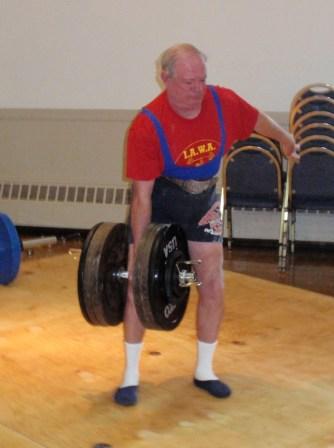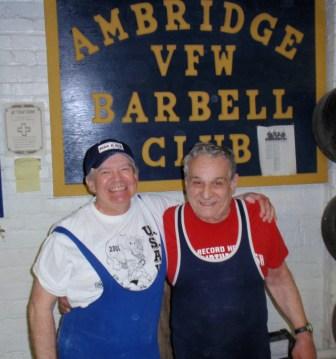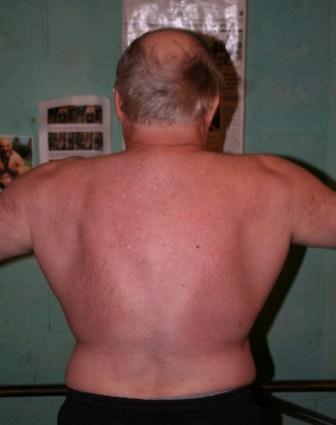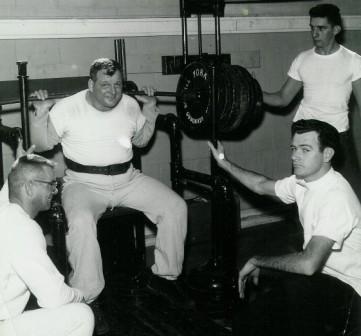John McKean

John McKean, at 64 years of age and in the 80 kg class, performed a 120.9 kilogram One Arm Dumbbell Deadlift at the 2010 IAWA Gold Cup last month. This is the best One Arm Dumbbell Deadlift in the USAWA Record List, regardless of weight class, for lifters over 60 years of age.
Fierce looking, amazingly muscular, and sullen , the 181 pound powerlifter sat alone in a corner of the Ambridge VFW gym during one of our 1960s powerlifting meets. Nobody was crazy enough to disturb the thick thighed monster as he death-stared the warmup platform. Except me, of course; the resident nut! Surprisingly gracious and talkative, the young (but already bald & fu-manchu mustashed), record setting squatter explained his very basic leg routine -simply work up in singles from a power rack’s parallel pin position, starting dead stop at the bottom (eliminating rebound or “stretch-reflex”), going to an absolute limit, once per week. I’m sure this eventual all time great altered his approach over the years, yet not long ago I heard he became the only master lifter over 50 to set an official squat of over 900 pounds!
A similar power rack approach was taken by legendary Paul Anderson. In a story by Terry Todd, who witnessed the training, mighty Paul had 1050 pounds situated on a below parallel pin position (so low, recalled Todd, that he himself couldn’t even squeeze himself under it). Anderson easily got himself up from this dead stop bottom position, many singles during training, figuring such easy work (for HIM!!) would allow a “regular” squat with 1150-1400 pounds!!
Olympian Russ Knipp, who the astounded Russians called one of the strongest pure pressers and squatters they had ever seen, described to me his “2/3 squats”. Again, these were performed from dead stop in a position just a hair above parallel. Just over the middleweight bodyweight limit, Russ used to do these for 5 sets of 10 with 515 pounds -and not even pushing it, as they were supplementary exercise for his olympic lifting! Russ told me after this “overload” work, any regular squat always felt easy & he never had trouble getting up from low 400+ pound cleans!
Of course, based on progress by these true giants of lifting, I, at my powerlifting best – an awkward, small boned, unmuscular little 165 pound geek- discovered that rack bottom-start squats took my stalled contest lift of around 450 up to a state record 555 in amazingly rapid time. And this was before super suits, big belts, wraps, and all the other “aids” were around.
OK, enter All-Round lifting -we have LOTS of quality lifts that build the same core strength in dead start fashion, as did the rack pin squats, without the need of a bulky, space consuming power rack station. Think about it – our Jefferson, trap bar deadlift, dumbbell deadlifts, Zercher, and others start with no momentum -on the floor- and work the same important core muscles. If modern athletes would simply adopt a few of our sheer strength movements, they would be WAY ahead on FUNCTIONAL power, as opposed to trying to mimic modern powerlifting’s super-duper suited/wrapped, enhanced quarter squats and steel spring shirted, assisted bench presses.
As a long time secondary teacher, I always cringed at the ridiculous weight training that high school and college football, wrestling, and track coaches offered to their athletes. Many times coaches that I knew would simply go to the internet and select bodybuilding style programs, as they themselves had no real experience (and their coaching egos would NEVER have them ask an actual weightlifter!!). I heard of one school’s “strength- coach” who had senior football players do nothing but curls(!!!!), and another who trained female soccer players, but not allow anything heavier, ever, than 3 pound dumbbells! Equally upsetting were the athletic departments that would tell the youngsters to just do the powerlifts on their own -yep, more quarter squats, bounced bench presses, deadlift injuries, and the ever present assistance gear that easily conned kids bought on their own!
It seems to me that we in the USAWA could maybe initiate all-round contests or, at least, seminars, on high school & college campuses to demonstrate the superiority of our “old time” training methods. Certainly we could really help athletic programs that could use REAL strength training for their students, and, who knows, our base of competition oriented lifters could expand tremendously!



